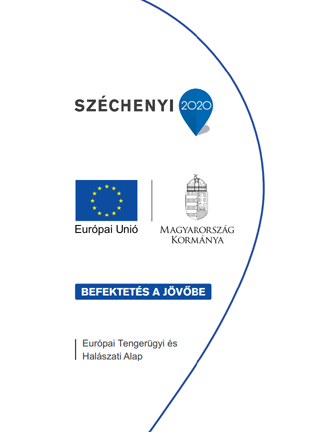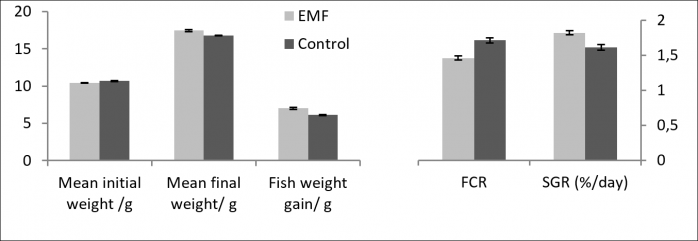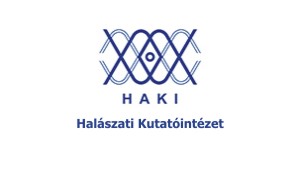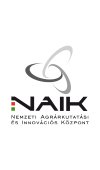
Water quality and growth performance of fish under the exposure effect of electromagnetic fields
Tareq Irhayyim, Gábor Beliczky, Máté Havasi and Miklós Bercsényi
Georgikon Aquatic Research Laboratory, Department of Animal Science, University of Pannonia, Keszthely H-8360, Hungary. Corresponding author, Tareq Irhayyim, e-mail: tareqsaad72[at]yahoo.com
Abstract
The study was aimed to assess the impacts of the electromagnetic field (EMF) on water quality and growth performance of common carp (Cyprinus carpio L) in recirculating aquaculture systems (RASs). Two treatments with three replicates were set up in a randomized design. The experimental treatment was supplied with the electromagnetic field device, while there was no device in the control treatment. The growth rate of fish, feeding efficiency and water quality parameters were measured in all systems to assess the impacts of the electromagnetic field in the RAS. The results showed that the use of the electromagnetic field (0.8 Millitesla) improved the feeding efficiency and growth performance of common carp. However, the electromagnetic field had no significant effect on water quality parameters in the RAS.
Introduction
In the last few decades, there has been an increase in the use of the electromagnetic field in different sectors such as farming and agriculture, food processing, wastewater treatment and scale prevention. The potentials of magnetic treatment in different fields of environmental management have been highlighted in different studies (Ali et al. 2014). However, the application of the magnetic treatment in aquaculture sector is still a new approach. Several studies have been conducted to test the effect of magnetic field in aquaculture (Krzemieniewski et al. 2004; Schultz et al. 2010; Hassan S. and Rahman R. 2016; Hassan et al. 2018); while still there is limited information available regarding the potential of using the electromagnetic field in aquaculture. Therefore, the purpose of this study was to evaluate the influence of the electromagnetic field on water quality and growth performance of common carp in recirculating aquaculture systems (RASs).
Materials and Methods
Materials and experimental design
The trial was conducted in Georgikon Aquatic Research Laboratory (GARL), Keszthely, Hungary. Common carp individuals (average size: 10.59 ± 0.06 g) were acclimated to the laboratory conditions before commencing the trial. The trial comprised six independent RASs; each system consisted of three tanks: a fish tank, a waste-collection tank and a biological filter tank. All three tanks were connected and operated under RAS. Two treatments with three replicates were set up in a randomized design. The first treatment was supplied with an electromagnetic device; while the control treatment was set up without the electromagnetic device. The electromagnetic field was generated in a coil by currents using a commercial electromagnetic field generator with a frequency of 25 kilohertz (kHz) and an intensity of 0.8 Millitesla (mT) (Electromagnetic Field Generator Multi Plus; manufactured by IVT Innovative Versorgungs-Technik GmbH, Hirschau, Germany) (Figure1).
Fish were stocked at a density of 12 fish per tank. The feeding rate was 3.5% of the total biomass. The flow rate of water was set at 3 litres per minute and approximately 30% of the system water was siphoned out weekly and replaced with new water.

Figure 1: Electromagnetic field generator Multi Plus used in the trial
Analytical procedures
Specific growth rates (SGR) and fish weight gain were calculated using the formulas: SGR (% day) = 100 × (lnWt−lnW0)/t and WG = Wt - W0; where Wt and W0 are the weight of fish at the sampling time and the start of the trial respectively; while (t) is the number of rearing days. The feed conversion ratio (FCR) was calculated as follows: FCR = WF (g) / WG (g), where WF is the weight of feed given to the fish (g) and WG is the weight gain (g).
The concentrations of ammonium nitrogen (NH4-N), nitrite nitrogen (NO2-N) and nitrate nitrogen (NO3-N) were measured weekly in all fish tanks. Dissolved oxygen (DO), temperature and pH of water in the fish tanks were measured once a day before feeding commenced.
All statistical analyses were performed using the Microsoft Excel and SPSS version 22.0 for Windows package.
Results and Discussion
Water quality in the fish tanks
All water quality parameters in the fish tanks of the treatments were at the levels recommended for common carp aquaculture (Timmons et al. 2002). However, there were no significant differences (P>0.05) in the overall mean of water quality parameters between the electromagnetic field system (EMF) and the control system (Table 1). The results of this study are in agreement with the findings of various authors (Krzemieniewski et al. 2004; Hassan et al. 2018) who found no changes in water quality concentrations between the electromagnetic field system and the control system. Contrary to our results, previous studies have shown an improvement in the water properties of the electromagnetic treatments (Krzemieniewski et al. 2003; Hassan S. and Rahman R. 2016). The differences between our results and the results of the provirus studies could be related to the lower magnetic intensity (0.8 mT) used, compared to the previous studies (100-200 mT).
Table 1: Water quality parameters in fish tanks after exposure to the electromagnetic field in RAS
| EMF | Control | |
| NH4-N (mg L−1) | 0.050±0.011a | 0.078±0.008a |
| NO2-N (mg L−1) | 0.141±0.045a | 0.145±0.052a |
| NO3-N (mg L−1) | 5.95±0.88a | 6.62±1.03a |
| DO (mg L−1) | 7.96±0.066a | 7.95±0.070a |
| pH | 7.27±0.021a | 7.28±0.020a |
| Temperature (°C) | 23.96±0.28a | 23.93±0.28a |
Values (means ± SE) having the same superscript letters are not significantly different
Growth performance of fish
The growth rate of common carp increased in all treatments. The mean SGR and weight gain of fish reared in the electromagnetic field system were significantly higher (P<0.05) than the control system (Figure 2). Similarly, Hassan et al. (2018) concluded that magnetised water improved the growth of tilapia in the RAS. The differences in the SGR between the treatments could be related to differences in food consumption by fish; because the best FCR in our study was achieved at the EMF group (Figure 2). Previous studies revealed that the magnetic field can change the water’s surface tension, density, viscosity, hardness, conductivity and solubility of solid matter; and these changes in water properties can affect the biological activities of the organisms (Gabrielli et al. 2001; Krzemieniewski et al. 2003; Krzemieniewski et al. 2004). The magnetic biological effect is related to biomass metabolism, enzyme activity and cell membrane permeability (Liu et al. 2008).

Figure 2: Growth performance of fish after exposure to the electromagnetic field in RAS
Conclusions
The results of this paper demonstrated that the growth of common carp and feed utilization efficiency increased after the exposure to the electromagnetic field (0.8 mT) in the RAS. The results also showed that the use of the electromagnetic field had no significant effect on water quality parameters.
Keywords: common carp, electromagnetic field, recirculating aquaculture systems
Acknowledgements
The work was supported by the Tempus Public Foundation/ StipendiumHungaricum scholarship, as well as the EFOP-3.6.3-VEKOP-16-2017-00008 project and HOP-3 COLL-1 (reference number: 1699279607) which are co-financed by the European Union and the European Social Fund.
References
Ali Y; Samaneh R; Zohre R; Mostafa J. 2014. Magnetic water treatment in environmental management: A review of the recent advances and future perspectives. Current World Environment. 9 (3), 1008-1016.
Gabrielli C; Jaouhari R; Maurin G; Keddam M. 2001. Magnetic water treatment for scale prevention. Water Research. 35(13), 3249-3259.
Hassan S. and Rahman R. 2016. Effects of Exposure to Magnetic Field on Water Properties and Hatchability of Artemia salina. ARPN Journal of Agricultural & Biological Sciences. 11, 416-423.
Hassan S; Sulaiman M; Abdul Rahman R; Kamaruddin R. 2018. Effects of long term and continuous magnetic field exposure on the water properties, growth performance, plasma biochemistry and body composition of tilapia in a recirculating aquaculture system. Aquacultural Engineering. 83, 76–84.
Krzemieniewski M; Debowski M; Janczukowicz W; Pesta J. 2003. Changes of tap water and fish-pond water properties induced by magnetic treatment. Polish Journal of Natural Sciences. 14.
Krzemieniewski M; Teodorowicz M; Debowski M; Pesta J. 2004. Effect of a constant magnetic field on water quality and rearing of European sheatfish Silurus glanis L. larvae. Aquaculture Research. 35 (6), 568–573.
Liu S; Yang F; Meng F; Chen H; Gong Z. 2008. Enhanced anammox consortium activity for nitrogen removal: Impacts of static magnetic field. Journal of Biotechnology. 138, 96–102
Schultz I; Pratt W; Woodruf D; Roesijadi G; Marshall K. 2010. Effects of Electromagnetic Fields on Fish and Invertebrates. Pacific Northwest National Laboratory, Washington.
Timmons M; Ebeling J; Wheaton F; Summerfelt S; Vinci B. 2002. Recirculating Aquaculture Systems. 2nd. edn. Cayuga Aqua Ventures, Ithaca, USA.
Programajánló
Hírek
Tisztelt Látogatók!
A hazai agrár-felsőoktatás szükséges megújulásának mérföldköve az alapítványi fenntartású Magyar Agrár- és Élettudományi Egyetem (MATE) létrejötte, amely 2021. február 1-től 5 campuson, több mint 13 ezer hallgató számára fogja össze a dunántúli és közép-magyarországi élettudományi és kapcsolódó képzéseket. Az intézményhez csatlakozik a Nemzeti Agrárkutatási és Innovációs Központ (NAIK) 11 kutatóintézete is, így az új intézmény nem csupán egy oktatási intézmény lesz, hanem az ágazat szellemi, szakpolitikai és innovációs központjává válik, amely nagyobb mozgásteret biztosít a képzések, a gazdálkodás és szervezet modernizálásához, fejlesztéséhez. Az összeolvadással magasabb fokozatra kapcsolunk, a kutatói és egyetemi szféra szorosabban fonódik majd össze, aminek következtében még több érdekes, izgalmas kutatás-fejlesztés születhet majd az agrárium területén.
Kérjük, kövesse tevékenységünket a jövőben is a www.uni-mate.hu honlapon!
A szokásostól eltérően az idei évben ősszel, október 03-04 között került megrendezésre az Ultrabalaton csapatversenye. NAIK-os csapat az idei évben állt először rajthoz a 14. alkalommal kiírt versenyen.


